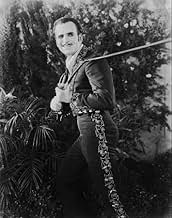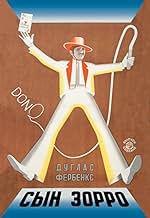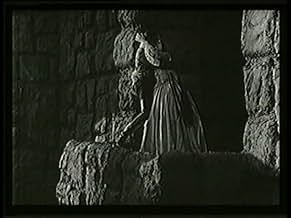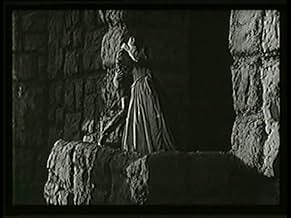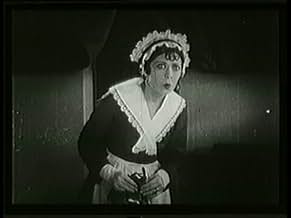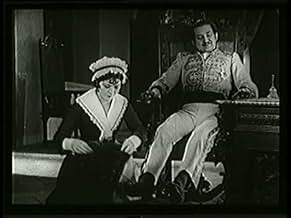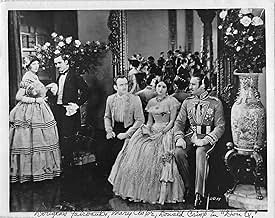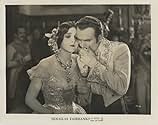Aggiungi una trama nella tua linguaDon Cesar, son of Zorro, is framed for murder while visiting Spain, and becomes the whip-wielding outlaw Don Q.Don Cesar, son of Zorro, is framed for murder while visiting Spain, and becomes the whip-wielding outlaw Don Q.Don Cesar, son of Zorro, is framed for murder while visiting Spain, and becomes the whip-wielding outlaw Don Q.
- Regia
- Sceneggiatura
- Star
- Premi
- 3 vittorie totali
Stella De Lanti
- Queen Isabella
- (as Stella DeLanti)
Lottie Pickford
- Lola
- (as Lottie Pickford Forrest)
George Blankman
- Undetermined Secondary Role
- (non citato nei titoli originali)
Charles Byer
- Undetermined Secondary Role
- (non citato nei titoli originali)
André Lanoy
- Artist
- (non citato nei titoli originali)
Recensioni in evidenza
The Mark of Zorro to me is one of the Douglas Fairbanks classics, and its sequel Don Q Son of Zorro is just as great and even on par with it. It looks spectacular with sets that look lavish and expensive and photography that positively sweeps. The music score rouses the spirits well enough and there is a sense of humour that has a strong presence and in a way that is still fresh. The story is well-paced and compelling with thrills, fun and adventure galore. It's conventional for a film starring Fairbanks and as an adventure film as well in a sense but not to a routine or simplistic degree, it is always easy to follow and still offers enough surprises. The action is full of energy and rousingly choreographed, never too much or too little and they move the story forward rather than slowing down. If you are looking for stunts that will leave you in awe, as you often find in Fairbanks's films, you will not be disappointed in Don Q Son of Zorro, they're unmistakably Fairbanks but don't feel rehashed. Donald Crisp directs with a deft and imaginative touch, and the characterisations are vivid enough, with the exception of Mary Astor who doesn't have a lot to do and comes across as bland as a result(shame as she has done a fair amount of stuff that I like). Crisp is especially good in support, he has rarely been more malevolent though not in a blatant way, and Don Sebastian is easily one of the nastiest villains of any Fairbanks film. Warner Oland is solid too if occasionally resorting to histrionics. Douglas Fairbanks is the most impressive though, the athletic stunts look so effortless when he does them and the gallant charisma and infectious smile makes him a most likable hero. To conclude, Mark of Zorro is still a classic and one of Fairbanks' greatest but Don Q Son of Zorro is just as great. 9/10 Bethany Cox
A sequel to one of Doug's best pictures that rousingly maintains the high standard of the original with much of the action played for laughs as Fairbanks effortlessly sees off the opposition while nonchalantly cracking a whip (even snapping a cigarette from Donald Crisp's mouth at one point!), mounting horses and performing other exhilarating feats of derring do.
Amidst all the macho brawling Lottie Pickford and Stella DeLanti (as the Queen) both make lively impressions in relatively brief roles; the latter early on, the former towards the end.
Amidst all the macho brawling Lottie Pickford and Stella DeLanti (as the Queen) both make lively impressions in relatively brief roles; the latter early on, the former towards the end.
Like his father a generation before, a young Californian caballero must fight against treachery & evil in high places.
DON Q SON OF ZORRO was Douglas Fairbanks' rousing sequel to his previous hit film, THE MARK OF ZORRO (1920). Much more expansive & elaborate than the first film, Fairbanks shows what he's learned about producing silent swashbucklers in the intervening five years. Mixing history, spectacle & lots of action, Doug always gave his audience their money's worth.
By this point in his career, Fairbanks was the absolute master of the swashbuckler. Whether romancing a fair señorita, fighting off hordes of enemy swordsmen, or jumping all about the architecture, his infectious grin & superb athletic prowess never fail to charm the viewer. And here he gets to charm twice, playing both father & son very nicely.
Doug is given wonderful support from three excellent character actors: Warner Oland as a silly Austrian Archduke whose foolish behavior precipitates the movie's crisis; Jean Hersholt as a social climbing buffoon who gets more than he bargained for; and vile Donald Crisp (who also directed) as the villain who wants both Fairbanks' life & sweetheart.
Although given little to do, Mary Astor is still a lovely heroine worth the fighting of several duels.
But this remains Fairbanks' film. His powerful personality & spectacular stunts not only dominate the movie, but also have ensured him an unassailable niche in Hollywood history.
DON Q SON OF ZORRO was Douglas Fairbanks' rousing sequel to his previous hit film, THE MARK OF ZORRO (1920). Much more expansive & elaborate than the first film, Fairbanks shows what he's learned about producing silent swashbucklers in the intervening five years. Mixing history, spectacle & lots of action, Doug always gave his audience their money's worth.
By this point in his career, Fairbanks was the absolute master of the swashbuckler. Whether romancing a fair señorita, fighting off hordes of enemy swordsmen, or jumping all about the architecture, his infectious grin & superb athletic prowess never fail to charm the viewer. And here he gets to charm twice, playing both father & son very nicely.
Doug is given wonderful support from three excellent character actors: Warner Oland as a silly Austrian Archduke whose foolish behavior precipitates the movie's crisis; Jean Hersholt as a social climbing buffoon who gets more than he bargained for; and vile Donald Crisp (who also directed) as the villain who wants both Fairbanks' life & sweetheart.
Although given little to do, Mary Astor is still a lovely heroine worth the fighting of several duels.
But this remains Fairbanks' film. His powerful personality & spectacular stunts not only dominate the movie, but also have ensured him an unassailable niche in Hollywood history.
After his artsy fantasy "The Thief of Baghdad" freaked everyone out, Doug got back to basics with this sequel to his first swashbuckler, "The Mark of Zorro" -- and concocted a meticulously designed, take-no-chances star vehicle. The sets, cast, and screenplay are all impressive but, as always, it's the Fairbanks persona -- an odd combination of pragmatist and dreamer, magician and acrobat, lover and fighter, rogue and moralist -- and his endless bag of tricks, gags, and stunts that sets the film apart from, not only 1920s action spectacles, but those of his successors: Jackie Chan, James Bond, and Indiana Jones.
Of his later pictures, perhaps only "The Gaucho" tops this one for sheer excellence in filmmaking.
Of his later pictures, perhaps only "The Gaucho" tops this one for sheer excellence in filmmaking.
The rollout for a Douglas Fairbanks movie during the summer was becoming a much-heralded annual ritual for movie fans. During the steamy days of 1925, the actor/producer released his sequel to the highly successful 1920 "The Mark of Zorro" in July 1925's "Don Q, Son of Zorro." Cinematic special effects created a double of Fairbanks as he appears in the film's later scenes as an aging Don Diego Vega (Zorro) while his son (Fairbanks) is seen in the same frame.
The actor/producer combined the Hesketh-Prichard 1909 novel 'Don Q.'s Love Story' with the Zorro character. Don Q, Cesar, possessed as his main defensive weapon a whip, but was also adept with the sword. And he never wears a mask to hide his identity. The story's location in Spain allows "Don Q" to have a totally different cast of characters, including Cesar's arch love rival, Sebastian (Donald Crisp), head of the Queen's Palace Guard. Crisp, released previously by Buster Keaton for his handling of portions of 1924's "The Navigator," capably directed "Don Q." Crisp was no slouch when it came to directing, sitting in the monogrammed chair for some 70 films before he went full-time acting.
It was an interesting time for lead actress Mary Astor, who played the love interest between Fairbanks and Crisp as Dolores. Just 19 years old and only a three-year veteran of the screen, Astor was one of a number of very young actresses whose parents lived off her salary. After discouraging actor John Barrymore from marrying their daughter while making 1924's "Beau Brummel," Otto and Helen Langhanke (Mary's birth name was Lucile Langhanke before Paramount Pictures changed it) controlled every aspect of her life.
Just after filming "Don Q," Mary was closely kept to her parents' hips when they bought a Moorish-style mansion known as 'Moorcrest,' in the hills above Hollywood just below the recently built famous sign. Charlie Chaplin previously rented the 1921 house, right across the Theosophical Society's utopian community called Krotona. The Langhankes became friends with Marie Hotchener, a Theosophist. When Marie heard the parents were taking Mary's entire $2,500 a week salary to pay the mortgage and other luxury items, she convinced the Langhandes to give their daughter $5 per week as an allowance.
Soon tiring from her father's physical and psychological abuse, Mary climbed out of her bedroom window and sought refuge in a Hollywood hotel. Mrs. Hotchener again became the intermediary between the family and negotiated her return to the parents by forcing them to deposit $500 in her bank account. Mary also supposedly obtained control of her finances, which never happened until she was 26, four years after she had married director Kenneth Hawks, the brother of film director Howard Hawks.
The actor/producer combined the Hesketh-Prichard 1909 novel 'Don Q.'s Love Story' with the Zorro character. Don Q, Cesar, possessed as his main defensive weapon a whip, but was also adept with the sword. And he never wears a mask to hide his identity. The story's location in Spain allows "Don Q" to have a totally different cast of characters, including Cesar's arch love rival, Sebastian (Donald Crisp), head of the Queen's Palace Guard. Crisp, released previously by Buster Keaton for his handling of portions of 1924's "The Navigator," capably directed "Don Q." Crisp was no slouch when it came to directing, sitting in the monogrammed chair for some 70 films before he went full-time acting.
It was an interesting time for lead actress Mary Astor, who played the love interest between Fairbanks and Crisp as Dolores. Just 19 years old and only a three-year veteran of the screen, Astor was one of a number of very young actresses whose parents lived off her salary. After discouraging actor John Barrymore from marrying their daughter while making 1924's "Beau Brummel," Otto and Helen Langhanke (Mary's birth name was Lucile Langhanke before Paramount Pictures changed it) controlled every aspect of her life.
Just after filming "Don Q," Mary was closely kept to her parents' hips when they bought a Moorish-style mansion known as 'Moorcrest,' in the hills above Hollywood just below the recently built famous sign. Charlie Chaplin previously rented the 1921 house, right across the Theosophical Society's utopian community called Krotona. The Langhankes became friends with Marie Hotchener, a Theosophist. When Marie heard the parents were taking Mary's entire $2,500 a week salary to pay the mortgage and other luxury items, she convinced the Langhandes to give their daughter $5 per week as an allowance.
Soon tiring from her father's physical and psychological abuse, Mary climbed out of her bedroom window and sought refuge in a Hollywood hotel. Mrs. Hotchener again became the intermediary between the family and negotiated her return to the parents by forcing them to deposit $500 in her bank account. Mary also supposedly obtained control of her finances, which never happened until she was 26, four years after she had married director Kenneth Hawks, the brother of film director Howard Hawks.
Lo sapevi?
- QuizDanish composer Jacob Gade's internationally famous piece "Tango Jalousi" was composed for the Danish gala premiere of this film, which took place 14 September 1925 in Palads Teatret, Copenhagen.
- Citazioni
Don Cesar de Vega: My father always said, "When you are in the right, fight; when you are in the wrong, acknowledge it."
- ConnessioniFeatured in Sprockets: Cliffhangers (1995)
I più visti
Accedi per valutare e creare un elenco di titoli salvati per ottenere consigli personalizzati
Dettagli
- Tempo di esecuzione
- 1h 51min(111 min)
- Mix di suoni
- Proporzioni
- 1.33 : 1
Contribuisci a questa pagina
Suggerisci una modifica o aggiungi i contenuti mancanti


